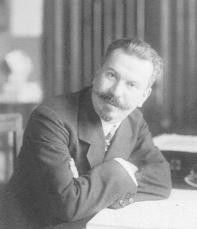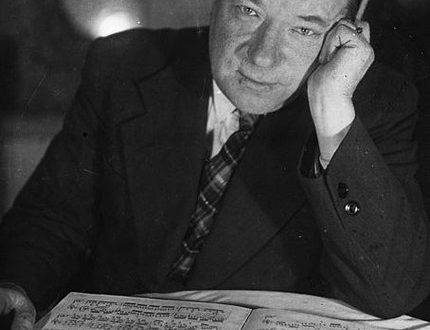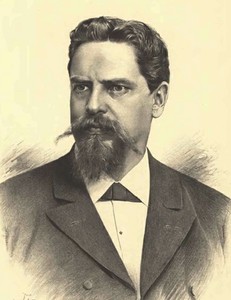
Sergey Nikyforovych Vasilenko (Sergei Vasilenko) |
Sergei Vasilenko
I came to this world to see the Sun. K. Balmont
Composer, conductor, teacher, musical and public figure S. Vasilenko developed as a creative individual in the pre-revolutionary years. The main basis of his musical style was a solid assimilation of the experience of Russian classics, but this did not exclude a keen interest in mastering a new range of expressive means. The composer’s family encouraged Vasilenko’s artistic interests. He studies the basics of composition under the guidance of the talented composer A. Grechaninov, is fond of painting by V. Polenov, V. Vasnetsov, M. Vrubel, V. Borisov-Musatov. “The connection between music and painting became more obvious to me every year,” Vasilenko wrote later. The young musician’s interest in history, especially Old Russian, was also great. The years of study at Moscow University (1891-95), the study of the humanities gave a lot for the development of artistic individuality. Vasilenko’s rapprochement with the famous Russian historian V. Klyuchevsky was of great importance. In 1895-1901. Vasilenko is a student at the Moscow Conservatory. The most prominent Russian musicians – S. Taneev, V. Safonov, M. Ippolitov-Ivanov – became his mentors and then friends. Through Taneyev, Vasilenko met P. Tchaikovsky. Gradually, his musical ties are expanding: Vasilenko is moving closer to Petersburgers – N. Rimsky-Korsakov, A. Glazunov, A. Lyadov, M. Balakirev; with music critics N. Kashkin and S. Kruglikov; with a connoisseur of Znamenny chant S. Smolensky. Meetings with A. Scriabin and S. Rachmaninov, who were starting their brilliant path, were always interesting.
Already in the Conservatory years, Vasilenko was the author of many compositions, the beginning of which was laid by the epic symphonic picture “Three Battles” (1895, based on the same article by A. K. Tolstoy). The Russian origin dominates in the opera-cantata The Tale of the Great City of Kitezh and the Quiet Lake Svetoyar (1902), and in the Epic Poem (1903), and in the First Symphony (1906), based on ancient Russian cult tunes. In the pre-revolutionary period of his creative career, Vasilenko paid tribute to some of the characteristic trends of our time, especially impressionism (the symphonic poem “Garden of Death”, the vocal suite “Spells”, etc.). Vasilenko’s creative path lasted for more than 60 years, he created more than 200 works covering a wide variety of musical genres – from romance and free adaptation of songs of many peoples, music for plays and films to symphonies and operas. The composer’s interest in Russian song and songs of the peoples of the world has always remained unchanged, deepened by numerous trips to Russia, European countries, Egypt, Syria, Turkey (“Maori Songs”, “Old Italian Songs”, “Songs of French Troubadours”, “Exotic Suite” etc.).
From 1906 until the end of his life Vasilenko taught at the Moscow Conservatory. More than one generation of musicians studied in his composition and instrumentation classes (An. Aleksandrov, A. V. Aleksandrov, N. Golovanov, V. Nechaev, D. Rogal-Levitsky, N. Chemberdzhi, D. Kabalevsky, A. Khachaturian and others. ). For 10 years (1907-17) Vasilenko was the organizer and conductor of the popular Historical Concerts. They were available to workers and students at low ticket prices, and the programs were designed to cover the entire richness of music from the 40th century onwards. and up to the present. Vasilenko gave almost 1942 years of intense creative work to the Soviet musical culture, with all his characteristic optimism and patriotism. Perhaps these qualities manifested themselves with particular force in his last, sixth opera, Suvorov (XNUMX).
Vasilenko willingly turned to ballet creativity. In his best ballets, the composer created colorful pictures of folk life, widely implementing the rhythms and melodies of various nations – Spanish in Lola, Italian in Mirandolina, Uzbek in Akbilyak.
Multinational folklore was also reflected in the coloristically colorful program symphonic works (symphonic suite “Turkmen Pictures”, “Hindu Suite”, “Carousel”, “Soviet East”, etc.). The national beginning is also leading in Vasilenko’s five symphonies. Thus, the “Arctic Symphony”, dedicated to the feat of the Chelyuskins, is based on Pomor melodies. Vasilenko was one of the initiators of creating music for Russian folk instruments. Widely known is his Concerto for balalaika and orchestra, written for the balalaika virtuoso N. Osipov.
Vasilenko’s vocal lyrics, original in terms of melodies and sharp rhythms, contain many bright pages (romances on the st. V. Bryusov, K. Balmont, I. Bunin, A. Blok, M. Lermontov).
Vasilenko’s creative heritage also includes his theoretical and literary works – “Instrumentation for a symphony orchestra”, “Pages of memories”. Vasilenko’s vivid lecture speeches to a mass audience, his cycles of lectures on music on the radio are memorable. An artist who faithfully served the people with his art, Vasilenko himself appreciated the measure of his creativity: “To live means to work with all the strength of one’s abilities and capabilities for the good of the Motherland.”
ABOUT. Tompakova





